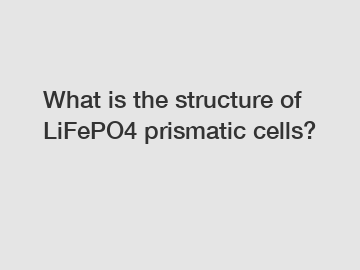Jan. 05, 2024
Electrical Equipment
Lithium Storage supply professional and honest service.
As our world moves towards sustainable energy solutions, lithium iron phosphate (LiFePO4) batteries have emerged as a game-changer in the field of rechargeable energy storage. With their long cycle life, high energy density, and excellent safety characteristics, these batteries have gained popularity across a wide range of applications. In this article, we delve into the intricate structure of LiFePO4 prismatic cells, unveiling the key elements that make them so impressive.
1. The Prismatic Cell Design:

LiFePO4 prismatic cells are named after their distinctive prismatic shape. Unlike cylindrical or pouch cells, prismatic cells are rectangular in shape, optimizing space utilization while providing enhanced stability. The solid design of prismatic cells offers superior mechanical strength, making them ideal for applications where high structural integrity is required.
2. Positive Electrode (Cathode):
At the heart of any lithium-ion battery lies the cathode, which in the case of LiFePO4 prismatic cells consists of lithium iron phosphate (LiFePO4). This compound is renowned for its exceptional stability and low-cost production. LiFePO4 is characterized by a crystal structure that enables lithium ions to move smoothly during the charging and discharging process, ensuring an efficient flow of energy.
3. Negative Electrode (Anode):
On the other side of the prismatic cell, we find the anode, typically composed of carbon-based materials. Graphite is commonly used due to its abundance and its ability to intercalate lithium ions during charging. The anode acts as a host, storing the lithium ions that travel back and forth during the charging and discharging cycles.
4. Electrolyte:
The electrolyte acts as a medium for ion transport between the anode and cathode. In LiFePO4 prismatic cells, a liquid or gel-like electrolyte is used, comprising a lithium salt dissolved in an organic solvent. The electrolyte ensures efficient flow of lithium ions from the anode to the cathode and vice versa, completing the energy storage cycle.
5. Separator:
The separator plays a crucial role in preventing short circuits and maintaining the integrity of the LiFePO4 prismatic cell. Typically made of a porous polymer material, the separator allows ions to pass through while preventing direct contact between the anode and cathode. This critical component also ensures the safety of the cell by preventing thermal runaway and reducing the risk of fire.
6. Housing and Current Collectors:
The structure of LiFePO4 prismatic cells includes sturdy housing materials to enclose the cell components and provide mechanical support. The housing is typically constructed using materials like aluminum or stainless steel, rendering the prismatic cell robust and durable. Additionally, current collectors made of conductive metals, such as copper or aluminum foil, facilitate the flow of electrons through the cell, supporting the charging/discharging process.
7. Thermal Regulation:
Thermal management is crucial to ensure the safe and efficient operation of LiFePO4 prismatic cells. Manufacturers often incorporate thermal regulation mechanisms into the cell design, such as ventilation channels or conductive cooling materials. These features help dissipate heat generated during high-power operations, optimizing the overall performance and lifespan of the battery.
Conclusion:
LiFePO4 prismatic cells combine innovation with advanced design to deliver exceptional performance in rechargeable energy storage. Their robust structure, featuring lithium iron phosphate cathodes, carbon-based anodes, efficient electrolytes, separators, and thoughtful thermal management systems, highlights their ability to provide reliable power across various applications. By understanding the intricate structure of LiFePO4 prismatic cells, we gain a deeper appreciation for their importance in shaping the future of sustainable energy solutions.
You can find more information on our web, so please take a look.
Contact us to discuss your requirements of storage battery manufacturers. Our experienced sales team can help you identify the options that best suit your needs.
Previous: What is the price of 8 pin connector?
Next: Master Rf Analyzers: Everything You Need to Know About Troubleshooting Wireless Networks!
If you are interested in sending in a Guest Blogger Submission,welcome to write for us!
All Comments ( 0 )